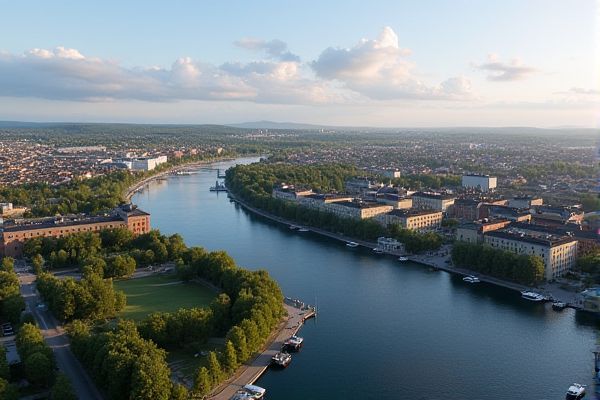
Weather and climate in Sweden: Cold winters, mild summers. Snow common November to April. Midnight sun in summer. Polar nights in winter. Temperatures vary by region. Frequent rain in southern Sweden. Windy coastal areas. Blizzards possible in northern regions. High humidity in autumn. Weather can change rapidly.
Cold winters, mild summers.
In Sweden, cold winters are characterized by temperatures ranging from 25F to 36F (-4C to 2C) in the south and center, and much colder in the north with temperatures frequently below freezing for up to eight months. Summers are mild and pleasant, with average high temperatures between 68F and 77F (20C and 25C) across the country, despite the northern latitude. For more detailed information on Sweden's weather patterns and what to expect when visiting, you can visit the TripReport website for comprehensive climate details.
Snow common November to April.
In Sweden, snow is a common feature from November to April, with the northern parts experiencing snow as early as October and as late as April. Meanwhile, the southern regions enjoy milder winters with shorter periods of snow and sub-zero temperatures. For more detailed insights, you can explore the information on the country's winter climate on the Visit Sweden website.
Midnight sun in summer.
The Midnight Sun in Sweden is a fascinating phenomenon where the sun stays above the horizon for 24 hours a day, occurring above the Arctic Circle from late May to mid-July, with the longest and brightest periods around the summer solstice. This unique natural event allows for continuous daylight, which encourages a variety of outdoor activities, including hiking, swimming, and camping without the sun setting. To delve deeper into this extraordinary natural occurrence, you can visit the Swedish Tourist Association website for more information and guidance on making the most of this experience.
Polar nights in winter.
In Sweden, particularly above the Arctic Circle, polar nights occur from late November to early January, characterized by the sun not rising above the horizon. Though the world is enveloped in darkness, a twilight period and moonlight beautifully illuminate the landscape. Despite the absence of direct sunlight, activities such as Northern Lights viewing and winter sports continue unabated, offering unique experiences of the Arctic environment during this mystical time.
Temperatures vary by region.
In Sweden, temperatures vary significantly by region, underscoring the country's diverse climate. The northern interior experiences severe winters with temperatures plunging as low as -22 to -40 °F (-30 to -40 °C) and enduring snowfall for up to eight months. In contrast, southern Sweden enjoys milder winters, with average January temperatures ranging between 23 and 32 °F (-5 and 0 °C). As for the summer months, conditions continue to diverge, with the south basking in warmth up to 20-25 °C (68-77 °F), while the north remains cooler around 15 °C (59 °F). For a more in-depth exploration of Sweden's climate, visit the comprehensive resource on Britannica.
Frequent rain in southern Sweden.
In Southern Sweden, while summer precipitation is expected to decrease, the region can still experience frequent and intense heavy precipitation events. Torrential rains, with levels above 40 mm per day, are projected to increase in frequency and intensity throughout the 21st century, posing a significant risk of floods. To learn more about how this impacts Sweden's policies, please visit the Sweden Climate Resilience Policy Indicator on the International Energy Agency's website.
Windy coastal areas.
In Sweden, particularly in coastal areas like Malmo's Nyhamnen district, strong and cold winds are a significant issue due to the proximity to the Oresund strait. The wind speeds are influenced by the surrounding built-up areas, which can decelerate wind speeds, but the area still experiences high wind speeds, especially from southwest, west, and northwest directions. For more information on wind patterns and urban impacts in Nyhamnen, the Oresund Strait provides detailed insights into these environmental challenges.
Blizzards possible in northern regions.
In northern Sweden, particularly in the interior and areas like Lappland, blizzards are possible due to the severe winter conditions that last up to eight months, with heavy snowfall and temperatures often dropping as low as -22 to -40 degF (-30 to -40 degC). The region experiences nearly 20 hours of total darkness in midwinter, exacerbating the harsh winter climate. For more detailed information about this phenomenon, you can explore the Climate of Sweden on Britannica. This area’s challenging weather patterns make it a unique and interesting subject of study.
High humidity in autumn.
In Sweden, autumn (September to November) is characterized by high humidity, with average humidity levels increasing from 77% in September to 87% in November, making the air normally humid throughout the season. For more information on the climate in Stockholm, visit the Climates to Travel website. This period sees a gradual decrease in temperature, preparing the region for the cold winter months that follow.
Weather can change rapidly.
Sweden's weather is characterized by rapid changes, particularly due to its northerly position and the influence of the Gulf Stream. This results in extreme temperature differences between winter and summer, with winters being severe above the Arctic Circle and mild in the south, and summers being relatively warm but not excessively hot. For more information on this fascinating topic, you can explore the detailed insights available on the Visit Sweden website.
